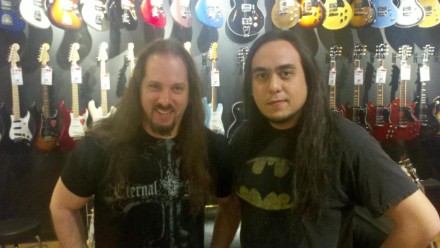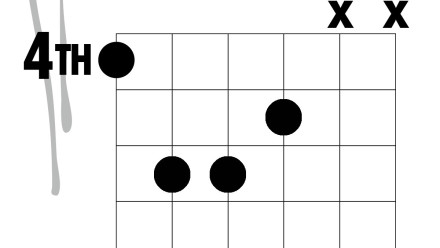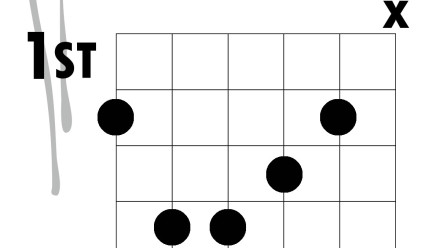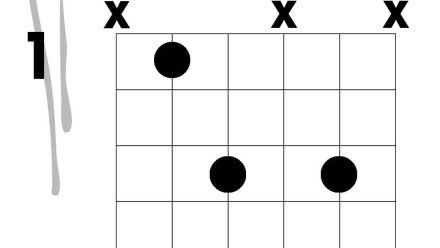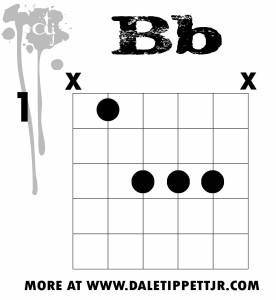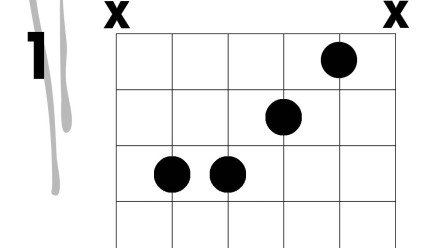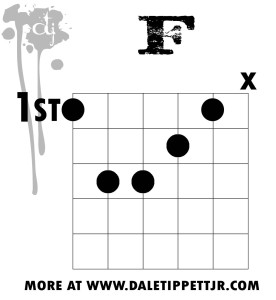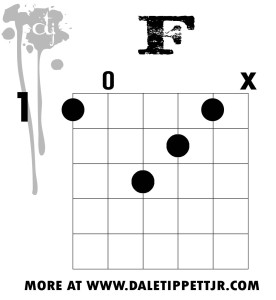Lessons on various guitar-related concepts
Category: Guitar Lessons
New Dream Theater Video: Looking Glass
Check this out:
Now, I don’t typically form too many opinions on music immediately after I hear it, or while I’m listening, so I won’t do any real music criticism on the song itself. If you’re a Dream Theater fan, I figure you’ll immediately like the song.
But would you look at that guitar!! It’s freakin’ gorgeous!!!
John Petrucci has the sweetest guitars, I swear. They play forever. And I mean it. You can play on these things for hours and not get tired. Seriously I don’t have much else to say. I just needed to get my fanboy on.
Chords for We Shall Overcome
It occurs to me that somebody might want to play the song at church or something over this weekend or on Monday or Tuesday, so here are the chords I use to play We Shall Overcome. In the video I did with Eric McGhee, I used an F chord to suspend the verse endings, and maybe I made a mistake here and there, but this will get you through the whole tune, however many verses you want to sing.
C F C C F C
We shall overcome, we shall overcome
C Am E7 Am D7 G
We shall ov – er – come someday
Am G/B C F C F C Fm
Oh – deep in my heart, I do believe
C F C G C
We shall overcome someday
Reading a text chart like this can get annoying, I think – but the only places I would expect any problems would be the Am E7 Am change on line 2, and the Am G/B change on line 3.
Of course you can watch the video for reference, but I’ll talk you through it real quick.
On line 2, think of the Am E7 Am change just like you sing the “o – ver – come” in the line. Am on beat 3, E7 on beat 4, and Am for beats 1 and 2 of the next measure.
For the “Oh” on line 3, the Am sits on beat 3 with the G/B on 4 so you get the sense of walking up to the C chord on the word “deep”.
Hope this comes in handy for you!
Db Chord Voicing Lesson
If I needed to be glib about it, I’d tell you to read what I had to say about Eb and Bb and shuffle it around a bit. But I think today I’ll be helpful. You’re welcome.
Db is one of those chords I don’t remember having to learn. Probably happened because of a church song. I probably played it like this:
-x-
-x-
-6-
-6-
-4-
-x-
And I probably played it like that because power chords are pro. Just sayin’.
Anyhoo, if you need a short answer, I would say do it like this:
I grab this shape using my first finger on the A string for the root, then my pinky barres the B, G and D strings. The fat muscle on my pinky gently mutes the high E string, excusing me from dealing with any unwanted noise.
This way is also good:
-x-
-6-
-x-
-6-
-4-
-x-
Learn up on it by fingering an A7 with your 3rd and 4th fingers, then slide that up and use your 1st finger to grab the Db on the A string. This one can be nice, especially if this isn’t your only flat chord. This version of the voicing strips it down, feels like an A7 chord, and can be pretty slick when slid in or out of.
On a side note, before I started writing this series, I totally went and tried to grab one of these for purely intellectual reasons:
-4-
-6-
-6-
-6-
-4-
-x-
SCREW THIS.
I worked out a couple different finger configurations and was still just left thinking to myself, “why would anyone do this?” The answer of course is “because nobody’s telling them otherwise”. What a pain and a waste of time. What this ‘is’ is an A-shaped barre chord (because it looks like an A cowboy chord). They’re just not useful until you start subtracting notes from them to make them playable in a song. So hop up, reduce it, then rock out.
You can do another one by using a C shape:
-x-
-2-
-1-
-3-
-4-
-x-
Learn this one (like Eb) by playing a C chord using your 2nd, 3rd and 4th fingers. Once you got that good and comfy, slide up a half-step and drop your 1st finger on the G string. Your incredibly powerful 1st finger’s chubby bottom-side will mute the high E string, and you might throw your thumb over the top to shut the low E string down. Otherwise, you might do this:
-x-
-2-
-1-
-3-
-4-
-1-(thumb)
And you got a nice Db/F sound to give a little depth.
Enjoy these, and we’ll get out of major chords, and start talking about minor chords, 7th chords, and all that jazz. Sometimes literally…
Barre Chord Cheats and Hacks Lesson: Major and Minor
Ok, so while the barre chord as-such is the last thing you should grab, you should know what one is and what it’s parts are. That way, when you start seeing unfamiliar chord symbols in a chart, you should be able to be able to pick out the most effective voicings for yourself.
Let’s do it in G! Here’s the big, dumb barre chord:
-3-
-3-
-4-
-5-
-5-
-3-
From the top (high E string) to the bottom (low E string) we have G, D, B, G, D, G. You’ll notice that we only have three note names: G, B and D. The repetition of these notes across the voicing is a great way to make reduction decisions, as far as simplifying down to its most necessary components. When you’re dealing with a plain old vanilla major chord, you really only need 2 notes. In this case, G and B – the root and third. Here’s a 10th chord voicing:
-x-
-x-
-4-
-x-
-x-
-3-
If you need the simplest possible minor chord, you can just flat the third, and you get this:
-x-
-x-
-3-
-x-
-x-
-3-
You can substitute a tenth chord voicing when you got NO clue what else is going on in the chord. If you need a quick augmented chord, play a major tenth and let the rest of the band deal with it – for a diminished copout, use a minor tenth. Just grab the shape and put your first finger on whatever the root’s name is. Booya.
Of course even when cheating, you need to at least know where the root of the chord is. So you do need to learn what the names of your frets are.
Learn it from Desi Serna. I’m not dealing with it. Click this sentence for links.
The second most infuriating barre chord is this one for Bb:
–1–
–3–
–3–
–3–
–1–
–1–
I filled out the barre, giving you an extra 5th at the bottom. Here’s the notes, High to low: F, D, Bb, F, Bb, F. We got 3 note names: Bb, D and F – root, third and fifth, respectively. If you gotta fake a major or Augmented chord, just play root and third. Here’s a tenth chord voicing of that:
–x–
–3–
–x–
–x–
–1–
–x–
And here’s the minor tenth:
–x–
–2–
–x–
–x–
–1–
–x–
If you gotta fake minor or diminished, grab that. These keep your sound from getting too thin by comparison of the chord shapes you’re already comfortable with. It still thins your sound a little, but it’s better than grabbing two close high notes or a power chord.
It’s like Game Genie for guitar! Have fun cheating at guitar, you guys!

Ab Chord Voicing Lesson
If you want the short answer, go read the F chord post and move it up 3 frets. IMHO it looks like this at its best:
-x-
-x-
-5-
-6-
-6-
-4-
You should be able to do this all day long. Occurs to me that you might see it’s resemblance to a power chord as well as a barre chord, but it’s somehow neither, right? I KNOW! that’s what makes it rock. The note on the G string, in this case C natural, is the major third of the chord, giving it the quality of being major, yada yada… Anyway, this is a great way to throw an Ab chord ito your vocabulary.
Now the fun ones.
-x–x–x
-1–1–1
-1–1–1
-1–1–1
-3–x–3
-4–4–x
So there’s three more. These are pretty easy to grab, very grokkable, and sound more like a cowboy G chord without cramping up your hand or forcing you into a full barre chord.
For the first and second voicings out of these three, I’d suggest grabbing a cowboy G chord with your 3rd and 4th fingers on the two lowest notes. In this case you won’t be using your 2nd finger for anything, so try not to look like you’re flipping the bird at your audience. Try and keep it low, near your first finger which is barring the B, G and D strings.
The only variation in the second voicing is the lack of the note C on the A string. The voicing is still major though, since we have a C note on the B string, first fret. This one might be faster to grab though, depending on the situation you’re in.
The third voicing however is definitely my favorite. If I’m not in the key of Ab, or I’m on the last couple counts of and Ab in a progression, I’ll grab this one. It creates a sense of a moving bass line, and I think it’s just pretty. You’d see it on a chart as Ab/C, but that doesn’t matter. It’s pretty rare that a slash chord really matters on a chart. I should probably write about slash chords sometime. They blow the beginners’ minds, and annoy those of us who were planning on doing them anyway.
Play well, you guys.
Eb Chord Voicing Lesson – When One Lower Is Eleven Higher
I’m thinking back on it now, and I don’t think anybody ever taught me an Eb chord… It’s the kind of thing that (close as I can figure) came about from learning a Stone Temple Pilots song or something. ALSO, it was probably this:
-x-
-x-
-x-
-8-
-6-
-x-
or this:
-x-
-x-
-8-
-8-
-6-
-x-
but either way, those are kind of still functional. However if you look at what I do with Bb, you’ll see where I’m driving for now. Here’s 2 in 6th position for you:
-x—–x—
-8—–8—
-8—–x—
-8—–8—
-6—–6—
-x—–x—
The benefit of the first one is that it’s voiced like an A chord, pleasing to the ear, and in general, fine-and-or-dandy. The second one leaves more room for other instruments and is real quick to grab because you’re not flattening a finger across three strings.
But that’s not all!
I like an Eb in lower positions whenever possible. My current favorite is this:
-x-
-4-
-3-
-1-
-x-
-3-
The fingering for this one is deceptively simple. If you’re having a problem with it, I’d say start by setting up the top three notes with fingers 1, 3 and 4 – like a power chord with the octave on the B string, then using your middle finger to grab the low G on the low E string. The meat of your middle finger should mute the A string handily, and your lazy pinky will kill the high E string without any trouble.
This voicing is super cool! One of my favorite things to grab when I’m playing a D chord is the F# on the low E string. The wideness of the interval between the low and high notes gives an illusion of more notes being played, and it gives a sense of motion, which is super helpful if you’re aiming to land on an Ab, or if you were on Ab, going to F minor like this:
-x–x–x
-x–5–x
-5–4–1
-6–1–3
-6–x–3
-4–3–1
Last word for now on how to get a great sounding Eb chord is this voicing here:
-x-
-4-
-3-
-5-
-6-
-x-
Looks like a C chord. Plays like one too, but you have to finger the basic C shape with your 2nd, 3rd and 4th fingers, so that’s where I’d start if you need to strengthen your shameful pinky… Anyway, it becomes super sweet and easy when you can grab the Bb note on your G string (third fret) with your first finger.
This shape is great for a mid-range sound. Not too much high or low, doesn’t get in anybody’s way. Sometimes you’ll find that the power/barre looking voicings at the top of this page sound too punk rock or happy, and you want some closer harmonies to tighten a progression up. This is the one for that situation. There’s some moving bass pattern implications to this voicing that we can talk about later if you wanna talk about it, but for now, go play.
Gb Chord Voicing Lesson
TONS of songs are in the key of G. It’s pretty much my favorite, if for no other reason than I like the feel of a G chord under my hand. G flat, though, is just annoying. It’s so close to being cool, but nobody’s perfect. Here are the only voicings I use that are near first position:
–x—–x—-x
–x—–2—-2
–3—–3—-3
–4—–4—-4
–4—–4—-4
–2—–2—-x
All are super similar, but depending on what my hand is doing before, after, or during the time I’m hanging out with Gb, I’ll grab a different one.
The first one is great as a I chord. It’s stable, theres no motion implied, it just sits there being Gb. Fat on the lower part of your first finger should mute the high strings, E and B. It looks and functions exactly like a Gb barre chord would work traditionally, but you don’t cramp, and a missed grab won’t cause unwanted noise in the high register.
The second one adds the fifth (Db) to the high register. I grab the hell out of this one. Sometimes a little more high end goes a long way. The way to get this without barring across 5 strings (because otherwise you might as well be playing a big barre chord like a scrub) is to play the Db on the B string with your first finger. Then grab the G and D strings with your 2nd and 4th fingers, respectively. That forces your ring finger above, pretty much right where it needs to be in the fourth fret of the A string. The low tonic (Gb) is grabbable by your thumb over the top of the neck. Once you get to feeling this out, you’re golden. First finger mutes the high E string again.
The third fingering is identical to the second, except your thumb is muting the low E string instead of playing it. This one is useful when you are in Db and you want the IV chord sound like it’s moving upward in sound, or you want a sus4 type sound when compared to your Db chord. You don’t get that effect when the lowest note in your voicing is a fifth below the lowest note on your last chord.
Looking at a chord like this conceptually, I was thinking about how often I need this information. Honestly, I learned a lot of what I know so I can put songs in easier guitar keys. When I see a song in Gb, I take an inventory of what other instrumentalists I have, and if I can, I tell everybody to play it in G. If the melody gets too high, I push down to F.
But that’s the thing. Sometimes I’ll be backing up a vocalist, and they straight up need the thing in Gb. It’s not their problem, it’s just I don’t have a ton of fun in Gb. It’s their jam, and I want to do my job well. So I play in uncomfortable keys sometimes. So if you want to do this kind of thing for real, for a living – then get these grips down and learn your craft. Catch ya.
Bb Chord Lesson, or “How I Stopped Learning Barre Chords and Started Living the Good Life”
Seriously.
Bb is one of those other chords that tend to give a bit of a headache when a beginner is looking to play guitar. They see this guy right here:
SCREW THIS:
–1–
–3–
–3–
–3–
–1–
–x–
And then there’s a bunch of time wasted trying to squish your fingers around in such a way as to let that high F-note on the E string ring out. It’s unnecessary, unless you’re a bigot, of course, but that’s beside the point.
If you or a guitar player you know has a serious problem with the voicing mocked above, check these out:
All three of these fulfill the requirements of being a Bb chord, while simultaneously NOT giving you carpal tunnel syndrome. The first finger barre is eliminated in all three cases. That’s a great start. In the first voicing, you can barre the B, G, and D strings with either your 3rd or 4th finger. I prefer my 4th, cuz my pinky is a MONSTER.
The 2nd and third voicings are very similar but have a pretty big difference between them. The 2nd one is great in a situation where you like having tight, simple sounds and all the other chords surrounding it have no open strings in their voicings. Super cool in F, Bb and Eb. Doesn’t get in the way, and is pretty intuitive. Looks like an A7 chord bumped up a fret.
Have I mentioned that you should play all your cowboy chords with fingers 2, 3 and 4 yet? Doing this gets your hand prepared to pop a first finger down for a simulated barre, AND strengthens your puny finger muscles AND makes most new chord voicings much more grokkable.
The third voicing is a pet of mine, but I don’t use it too often. It’s charm comes from the open D string ringing under your first finger arch. This voicing is great if you have a C chord near it. One of the things about Open cowboy chords is that they all have these great free ringing strings in them and They’re so lush. Playing a choked out flat chord or F makes for a sudden shift in timbre that leaves you wanting more. Giving this Bb chord an open D in it gives it a feeling of unity with your surrounding cowboy chords. Also look at how I do F.
The first two voicings are super important for you to keep in your hip pocket though. These stand in for all major barre chords with the tonic on the A string. Learn that, and have a better time learning music instead of giving yourself cramps and a headache.
F Chord Voicing Lesson
The F chord has to be the one voicing that ruins every beginning guitarist’s day. The first version of the chord you’re shown is usually all high strings with a short barre on the E and B strings.
SCREW THIS:
–1–
–1–
–2–
–3–
–x–
–x–
–x–
Buncha things about that voicing bother me but here’s three:
- It’s way too thin. Especially on a solo acoustic guitar, I usually want a full, lush sound, like I get on an open E or G chord, but that 4-string F voicing is all highs and mids with no BODY to it.
- The short barre at the top is crazy uncomfortable, beginners get a bad buzzing sound or sloppy muted noises on the high E string.
- In the context of a song, it’s really kinda useless. Boo.
Next Voicing you learn is the big barre chord version, spanning all six strings, like a big, fat E chord. The beginner’s hand get’s tired, and there is much complaining. AND it takes forever to get your hand into position. Screw that. There’s gotta be an easier way that sounds good too!
THIS ONE IS ALSO BAD:
–1–
–1–
–2–
–3–
–3–
–1–
So here’s my solution:
 This voicing adds a lower note (C, the fifth) to round out the low end and, in fact, give the aural illusion that you’re using the the low E string. The mid-range aspects of this F chord voicing is great, because it leaves room for vocals to fit in the sonic space around it, a bass player can catch the low tonic or third if desired, and it’s faster to grab than the big barre chord.
This voicing adds a lower note (C, the fifth) to round out the low end and, in fact, give the aural illusion that you’re using the the low E string. The mid-range aspects of this F chord voicing is great, because it leaves room for vocals to fit in the sonic space around it, a bass player can catch the low tonic or third if desired, and it’s faster to grab than the big barre chord.
Great thing about this voicing is that it’s movable. Wherever your pinky is, that’s the name of the chord, so go play! Half step up is Gb, then G, Ab, A, etc.
Caviat Audiens: Make sure you are muting the high and low E strings – high with the flesh of your first finger, and low with the flesh of your third finger OR your thumb over the top of the neck. For more on muting, check this post out
Now here’s 2 more that I use super frequent:
Not too different, but playing these gives you back any low end you might be missing. The highs are again, unnecessary. The first one is more useable, as far as my play style is concerned. I do tons of solo acoustic gigs, and it serves me well.
The second voicing brings out a low third on the open A string. The benefit of this is that it gives the chord an easier way to match the timbre of the chords around it in a situation where you are playing a lot of open cowboy chords. Use it as the IV chord in C, or the I chord in Amazing Grace (in bar 2 though) and you’ll hear the diference, and why it’s significant. There’s a TON of variations I use based on these voicings, but we’ll hit them later.
Rock on, you guys.
Muting: The Notes We DON’T Play
You know, sometimes we spend so much time playing other people’s music that we feel like we’re not spending any time developing our own style. I felt that way for a while – even when Something Beautiful is gigging a lot, I play more churches and private events than anything, and can easily fall into the loss-of-personal-identity trap. But after looking at my own playing, compared to how other guitarists around me play, I realized that all that playing was generating my own play style all along. It’s not necessarily writing that develops the style, it’s almost exclusively the playing that does it. Putting the hand in position, figuring out what feels good or easy, setting goals on learning new techniques – that stuff.
So after looking, I see that my playing is acoustic guitar based. I started learning on my dad’s acoustic when I was 7, and went on to write a ton of songs, even metal songs, on acoustic guitar. I gravitate back there not only because I’m comfortable there, but because I tend to play the drum parts I want to hear on the strings while I play a song. It gives me a sense of playing with an ensemble, and fills the imaginary space in my head when I need to understand how a song might feel when the rest of the band comes in. At solo acoustic gigs, I use the percussive effect of a heavy stroke on the muted strings to act as a snare drum on beats 2 and 4 – once an ensemble is added, I remove the heavier strokes and bring in the reigns on my right hand. An example of the artifacting of my right hand can be heard in What You Do, a song I play with Tin Lolita.
In that song, I’m still playing harder on beats 2 and 4, but I play notes and fills instead of the muted strings – which is why I’m writing, so lets get to it.
Start by playing less notes.
Being able to stop a string from ringing, using the left hand enables you to hit the strings a lot harder with a lot less danger of hearing notes that are outside of the chord – undesirable ones, of course. It also allows you to focus attention on to one note within the voicing. Gives a sense of motion. Sense of motion is a phase you’ll hear a lot in these guitar articles I’m writing. Just saying.
So what you should do is grab an open cowboy chord – any will do – and start removing notes by slightly lifting the fingers on your left hand. This is a tiny movement, but I find it rather essential. If you must, grab an E chord and lift the fingers you’re fretting with so you’re muting those strings. You’re left with 2 open E’s and a B string. Hit all six strings hard, and listen to the harmony. Press harder with your first finger, adding the G sharp – hit em all again, and listen to the change in the harmony. Add a finger, remove a finger, use your left pinky to mute the high E or B strings, and listen to all these variations on the same E chord just by taking a note out here and there. Moving or removing low notes gives a sense of bass motion, and moving or removing mid or high notes gives a sense of melody. It’s kind of like what you want to hear on a piano, but it’s all under your single left hand.
A word for beginners:
One of my least favorite questions is “which version of the chord should I use?” – I know it’s a valid question, becauseto the beginner, every variation on every chord is a new chord. What I want you to think about, and know – is that every finger variation in the above paragraph is still an E chord.
Best example – and most frequently asked about by scrubs, is which G chord:
Well, let’s all just agree to stop asking – they are both fine, pretty much the same, I don’t care which one you use. Just use whichever one is more comfortable, depending on what chords are around them, and call it a day.
Glad I put that one to bed 😉
Podcast: Play in new window | Download
